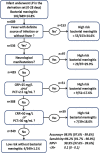A sequential guide to identify neonates with low bacterial meningitis risk: a multicenter study
- PMID: 33836125
- PMCID: PMC8108426
- DOI: 10.1002/acn3.51356
A sequential guide to identify neonates with low bacterial meningitis risk: a multicenter study
Abstract
Objective: To derive and validate a predictive algorithm integrating clinical and laboratory parameters to stratify a full-term neonate's risk level of having bacterial meningitis (BM).
Methods: A multicentered dataset was categorized into derivation (689 full-term neonates aged ≤28 days with a lumbar puncture [LP]) and external validation (383 neonates) datasets. A sequential algorithm with risk stratification for neonatal BM was constructed.
Results: In the derivation dataset, 102 neonates had BM (14.8%). Using stepwise regression analysis, fever, infection source absence, neurological manifestation, C-reactive protein (CRP), and procalcitonin were selected as optimal predictive sets for neonatal BM and introduced to a sequential algorithm. Based on the algorithm, 96.1% of BM cases (98 of 102) were identified, and 50.7% of the neonates (349 of 689) were classified as low risk. The algorithm's sensitivity and negative predictive value (NPV) in identifying neonates at low risk of BM were 96.2% (95% CI 91.7%-98.9%) and 98.9% (95% CI 97.6%-99.6%), respectively. In the validation dataset, sensitivity and NPV were 95.9% (95% CI 91.0%-100%) and 98.8% (95% CI 97.7%-100%).
Interpretation: The sequential algorithm can risk stratify neonates for BM with excellent predictive performance and prove helpful to clinicians in LP-related decision-making.
© 2021 The Authors. Annals of Clinical and Translational Neurology published by Wiley Periodicals LLC on behalf of American Neurological Association.
Conflict of interest statement
The authors have no conflict of interest to declare.
Figures




References
-
- Thigpen MC, Whitney CG, Messonnier NE, et al. Bacterial meningitis in the United States, 1998–2007. N Engl J Med 2011;364:2016–2025. - PubMed
-
- Libster R, Edwards KM, Levent F, et al. Long‐term outcomes of group B streptococcal meningitis. Pediatrics 2012;130:e8–e15. - PubMed
-
- Nigrovic LE, Kuppermann N, Neuman MI. Risk factors for traumatic or unsuccessful lumbar punctures in children. Ann Emerg Med 2007;49:762–771. - PubMed
-
- Stoll BJ, Hansen N, Fanaroff AA, et al. To tap or not to tap: high likelihood of meningitis without sepsis among very low birth weight infants. Pediatrics 2004;113:1181–1186. - PubMed
Publication types
MeSH terms
LinkOut - more resources
Full Text Sources
Other Literature Sources
Research Materials
Miscellaneous
